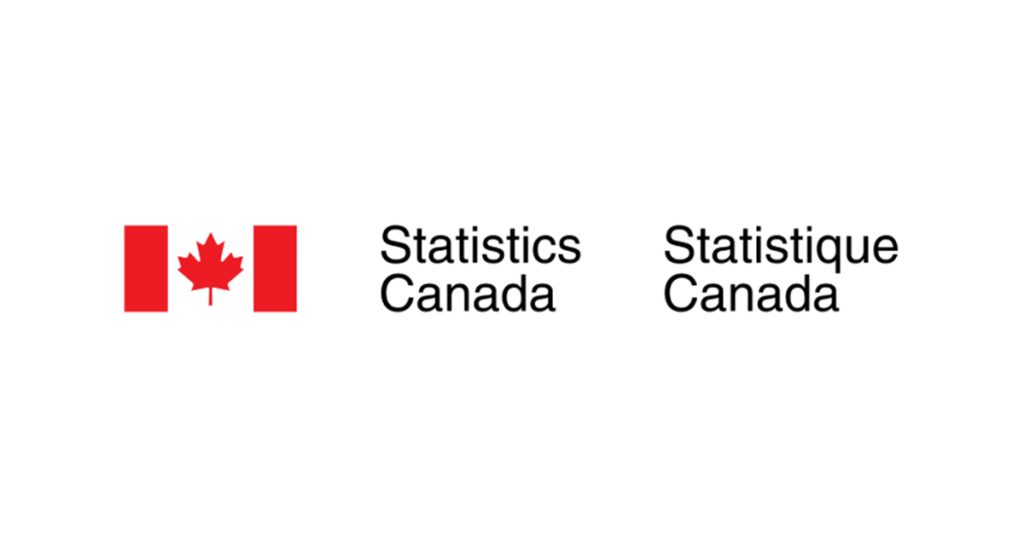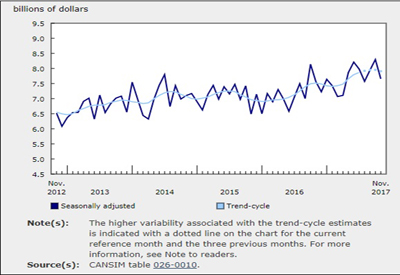Labour Force Survey, September 2025

October 15, 2025
Employment increased by 60,000 (+0.3%) in September and the employment rate rose by 0.1 percentage points to 60.6%. The unemployment rate was unchanged at 7.1%.
Employment was up in the core-aged group (25 to 54 years old) both for women (+76,000; +1.2%) and men (+33,000; +0.5%), while it fell among people aged 55 and older (-44,000; -1.0%). There was little change in employment for youth aged 15 to 24.
There were more people working in manufacturing (+28,000; +1.5%), health care and social assistance (+14,000; +0.5%) and agriculture (+13,000; +6.1%). On the other hand, employment decreased in wholesale and retail trade (-21,000; -0.7%).
Employment increased in Alberta (+43,000; +1.7%), New Brunswick (+4,700; +1.2%) and Manitoba (+3,900; +0.5%), while it declined in Newfoundland and Labrador (-2,200; -0.9%).
In September, there was an increase in full-time employment (+106,000; +0.6%) while part-time employment fell (-46,000; -1.2%).
Average hourly wages among employees increased 3.3% (+$1.17 to $36.78) on a year-over-year basis in September, following growth of 3.2% in August (not seasonally adjusted).
Employment up in September, following declines in previous two months
Employment increased by 60,000 (+0.3%) in September, partially offsetting a cumulative decline of 106,000 (-0.5%) over the previous two months. From January to September, employment has recorded little net growth (+22,000; +0.1%).
Chart 1
Employment rate up in September, following two consecutive declines

The employment rate—the proportion of the population aged 15 years and older who are employed—rose 0.1 percentage points to 60.6% in September, following consecutive declines in July and August. The employment rate in September was 0.5 percentage points lower than the recent peak of 61.1% recorded in January and February 2025.
The employment increase in September was concentrated in full-time work (+106,000; +0.6%). In comparison, part-time employment fell by 46,000 (-1.2%) in September. Both full-time and part-time employment were little changed compared with the beginning of the year.
In September, public sector employment rose by 31,000 (+0.7%). Variations in the number of private sector employees (+22,000; +0.2%) and self-employed workers (+7,900; +0.3%) were smaller in the month.
Employment rises for core-aged women and men
Employment increased in the core-aged group (25 to 54 years) both among women (+76,000; +1.2%) and men (+33,000; +0.5%) in September, following declines in August. This was associated with a rebound in the employment rate of core-aged women (+0.9 percentage points to 80.4%) and core-aged men (+0.3 percentage points to 86.1%) in September, from recent lows recorded in August.
Infographic 1
Employment rate by age group, September 2025

Employment fell among people aged 55 and older in September (-44,000; -1.0%) and the employment rate for this group decreased by 0.4 percentage points to 33.6%. On a year-over-year basis, the employment rate among people aged 55 and older was down 0.6 percentage points.
There was little change in employment for youth aged 15 to 24 in September and the employment rate for this group was unchanged at 53.8%. The youth employment rate had trended down from a high of 59.6% in March 2023 to 54.0% in August 2024, a rate not previously seen since February 1999 (excluding 2020 and 2021). Since August 2024, the youth employment rate has hovered around 54.0%.
Unemployment rate unchanged at 7.1%
The overall unemployment rate was unchanged at 7.1% in September, following a 0.2 percentage point increase in August. Since the start of 2025, the unemployment rate has increased by 0.5 percentage points.
There were more people in the labour force in September and the participation rate rose by 0.1 percentage points to 65.2%. This represents the proportion of the population aged 15 and older who were either employed or looking for work. The participation rate was unchanged on a year-over-year basis.
Unemployment rate down among core-aged men in September and up among people aged 55 and older
Among core-aged men, the unemployment rate fell 0.2 percentage points to 6.2% in September. Despite the decline in the month, it has generally trended up since the start of the year and was up 0.6 percentage points compared with January. Among core-aged women, the unemployment rate in September (5.8%) was little changed both in the month and compared with the start of the year.
Chart 2
Unemployment rate unchanged in September

The unemployment rate for people aged 55 and older rose 0.2 percentage points to 5.5% in September, coinciding with a decline in employment among that group. The increase in the unemployment rate among people aged 55 and older in September follows four consecutive months of little change.
Unemployment rate up among young students
Infographic 2
Unemployment rate by age group, September 2025

The youth unemployment rate edged up to 14.7% in September, the highest rate since September 2010 (excluding 2020 and 2021). Compared with 12 months earlier, the youth unemployment rate was up 1.2 percentage points.
The increase in the youth unemployment rate over the 12 months to September was primarily due to rising unemployment among students. In September 2025, the unemployment rate among youth attending school was 17.1%, up 3.1 percentage points from the same month in 2024. In comparison, the unemployment rate among youth not attending school was 11.9% in September, virtually unchanged from 12 months earlier (not seasonally adjusted).
The elevated unemployment rate among youth attending school in September follows a difficult summer student job market in 2025. On average over the months of May to August 2025, the unemployment rate for returning students—those who attended school full time in the spring and intended to return to school full time in the fall—stood at 17.9%, the highest rate since the summer of 2009 (18.0%), excluding the year 2020, during the COVID-19 pandemic (not seasonally adjusted).
Employment increases in manufacturing as well as health care and social assistance
Employment in manufacturing rose in September (+28,000; +1.5%), the first increase since January. The increase was concentrated in Ontario (+12,000) and Alberta (+7,900). Prior to the increase in September, employment in manufacturing had recorded a net decline of 58,000 (-3.1%) from January to August.
Chart 3
Employment change by industry, September 2025

In health care and social assistance, employment increased by 14,000 (+0.5%) in September, following little change in August. On a year-over-year basis, employment in health care and social assistance was up 53,000 (+1.8%).
Employment in agriculture rose in September (+13,000; +6.1%) for the first time since January. Gains were concentrated in Ontario (+5,200), Alberta (+4,500), and British Columbia (+2,900). Compared with September 2024, employment in agriculture was little changed.
Employment in wholesale and retail trade declined by 21,000 (-0.7%) in September, following little change in July and August. Despite the decline in September, employment in wholesale and retail trade was up by 61,000 (+2.1%) on a year-over-year basis.
Largest employment gain in Alberta
In Alberta, employment rose in September (+43,000; +1.7%), more than offsetting declines recorded in July and August. The unemployment rate in the province fell 0.6 percentage points to 7.8% in September and was little changed on a year-over-year basis. In September, the unemployment rates in the census metropolitan areas (CMAs) of Calgary (8.1%) and Edmonton (8.7%) were both little changed compared with 12 months earlier (three-month moving averages).
Map 1
Unemployment rate by province and territory, September 2025

Infographic 3
Unemployment rates by census metropolitan area (CMA)

Employment also increased in New Brunswick (+4,700; +1.2%) and Manitoba (+3,900; +0.5%) in September. Despite more people being employed, the unemployment rate increased in both provinces (by 0.4 percentage points to 8.1% in New Brunswick and by 0.5 percentage points to 6.2% in Manitoba), as more people searched for work.
In Quebec, employment was little changed for a third consecutive month in September. The unemployment rate in Quebec in September (5.7%) was down from the recent peak of 6.3% recorded in June, and little changed on a year-over-year basis.
Employment was also little changed in Ontario in September. The unemployment rate in the province increased by 0.2 percentage points to 7.9% in September, as more people searched for work. The unemployment rate in the province was up 0.8 percentage points from September 2024. In the CMA of Toronto, the unemployment rate was unchanged at 8.9% in September 2025 and was up 0.8 percentage points on a year-over-year basis (three-month moving averages).
In the spotlight
The proportion of people working in jobs unrelated to their education or training increases slightly
In addition to impacting the likelihood of finding a job, changing labour market conditions can affect the ability of workers to secure employment related to their skills and qualifications. This can mean having to accept a job that is unrelated to their field of study or a position for which they are overqualified in terms of their skills or experience.
In September 2025, the Labour Force Survey collected additional information related to skills mismatches, to measure the extent to which workers were in jobs related to their education or training and whether workers believed they were overqualified or underqualified for their job.
The analysis focuses on core-aged (25 to 54 years) workers with a postsecondary certificate diploma or degree, which includes apprenticeship or trades certificates or diplomas, other postsecondary certificates or diplomas below a bachelor’s degree as well as bachelor’s degrees and higher levels of education.
In September, 16.4% of core-aged workers with a postsecondary certificate, diploma or degree worked in a job or business that was unrelated to their education or training, up 0.9 percentage points from 12 months earlier. The increase was higher among workers aged 25 to 34 (+1.6 percentage points to 18.2%).
Core-aged workers who were recent immigrants (who had landed in Canada within the previous five years) remained more likely to be working in a job unrelated to their education or training (21.2%) than their counterparts who were born in Canada (15.2%). More than 4 in 10 recent immigrants (41.9%) reported this was mainly because no jobs were available in their field, or they had been unable to find a job related to their education or training. In contrast, Canadian-born workers (56.3%) were over three times more likely than core-aged recent immigrants (17.3%) to indicate that they were working in a job unrelated to their education or training mainly because they had chosen to work in a different type of job.
Overqualification increases among recent immigrants
In September 2025, 21.8% of core-aged workers with a postsecondary certificate, diploma or degree reported being overqualified for their current role, little changed compared with September 2024.
The proportion of recent immigrants who indicated that they were overqualified for their job reached 34.7% in September 2025, up 4.2 percentage points compared with September 2024. At the same time, this proportion fell slightly among workers born in Canada (-1.2 percentage points to 18.5%) and was little changed at 21.6% among established immigrants (admitted more than 10 years earlier).
In September 2025, recent immigrants who reported that they were overqualified were concentrated in sales and service (29.8%) and business, finance and administration (17.6%) occupations.











